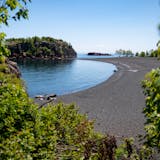I was nestled in a blind I had placed near a small pond. Through a tiny port in my hideout I saw a drake wood duck winging my way. Like a maple leaf in the wind, the wood duck — dressed in his springtime best — descended from the sky and landed within 30 feet of the blind. I scarcely dared to breathe. Spinning the focusing ring of my telephoto lens, I waited for the perfect chance to squeeze the shutter, knowing that one photo might be all I could get.
Wood ducks are easily startled by the sound of a camera's shutter.
When the flashy bird was within 20 feet it raised its crest and emitted a soft, high pitched whine to announce its presence to any unseen hens in the area.
Suddenly, I heard the sound of rushing wings. It was another drake wood duck and its mate landing nearby. At the sound of my motor-driven camera, the original drake flattened his elegant crest and eyed my blind suspiciously. Each time I tripped the camera's shutter, those blood-red eyes would give my blind the once-over. Eventually it decided the sound was not a threat, and all three birds went about their business.
The setting April sun lit the birds and they flashed iridescent hues of bronze, purple and green as the males fought and displayed, vying for the favors of the hen. She must have been impressed — I know I was. Male wood ducks are the most colorful of North American waterfowl. But the iridescent plumage can only be appreciated when the light is angled just so. A few degrees in either direction and the iridescence disappears.
The birds flew away only after I made a little too much noise while changing media cards in my camera.
Although the gaudy birds are rather secretive, they are also quite common in Minnesota. In spring, hen wood ducks seek natural tree cavities or man-made boxes in which to lay their eggs. The hen usually lays one egg a day, almost always in the morning. The drake will wait nearby while the hen goes about her task, which takes roughly one-half hour. She will use the wood shavings in the bottom of the box or nest cavity, as well as some down plucked from her breast, to cover the egg or eggs before she leaves the nest. Contrary to what many believe, the hen does not start incubation until her clutch is complete, usually 10 to 12 eggs.
When the hen has laid her last egg, incubation begins. At that point, the drake wood duck will permanently abandon the hen since his services are no longer needed. During incubation, the hen will leave her nest usually twice a day to feed, once in the morning and once in late afternoon.


